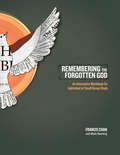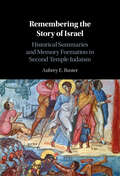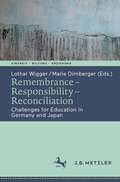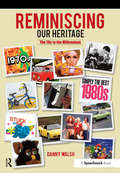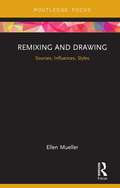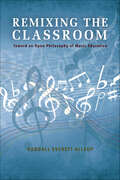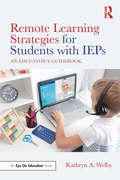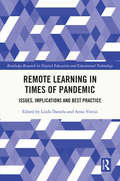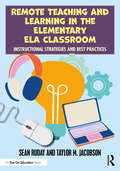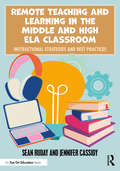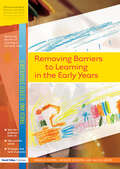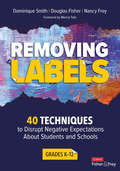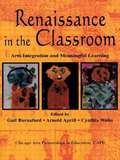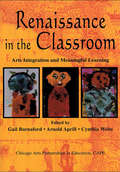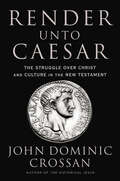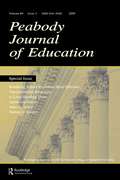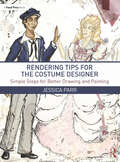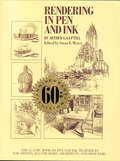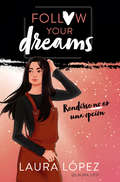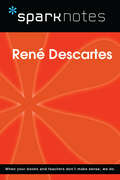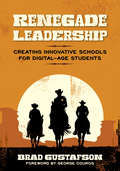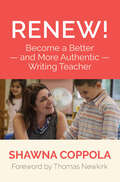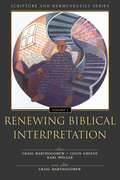- Table View
- List View
Remembering the Forgotten God
by Francis Chan Mark BeuvingIn this workbook companion to Forgotten God, author Francis Chan reminds us of the true source of the church's power--the Holy Spirit. Chan contends that we've ignored the Spirit for far too long, and that without Him, we operate in our own strength, only accomplishing human-sized results. Offering a compelling invitation to understand, embrace, and follow the Holy Spirit's direction in our lives the workbook is designed to initiate and facilitate both individual study, and small group discussion, interaction and practical application of the message of Forgotten God. The workbook will stand alone, or can be used alongside the Forgotten God DVD Study Resource. Francis' thought-provoking teaching makes this a valuable workbook resource for individual study, a seven-week small group study, churches, youth groups, and college campus ministries--and perfect for retreat weekends.
Remembering the Story of Israel Remembering the Story of Israel: Historical Summaries and Memory Formation in Second Temple Judaism
by Aubrey E. BusterIn this book, Aubrey Buster demonstrates how methods adapted from cultural and social memory studies and the new formalism can illuminate the communal function of biblical and extra-biblical historical summaries in Second Temple Judaism. Refining models drawn from memory studies, she applies them to ancient texts and demonstrates the development of Judah's speech about their past across the Second Temple period. Buster's wide-ranging study demonstrates how and where the historical summary functions in the book of Psalms, Nehemiah, 1 and 2 Chronicles, as well as the Qumran Psalms Scrolls, Words of the Luminaries, Paraphrase of Genesis and Exodus, and Pseudo-Daniel. She shows how the historical summary proves to be a generative, replicable, and ultimately productive form of memory. Crossing the boundaries of genre categories and time periods, liturgical performances, and literary works, historical summaries crafted a highly selective but broadly useful mode of commemoration of key events from Israel's past.
Remembrance – Responsibility – Reconciliation: Challenges for Education in Germany and Japan (Kindheit – Bildung – Erziehung. Philosophische Perspektiven)
by Lothar Wigger Marie DirnbergerGermany and Japan have taken different ways of dealing with the past of the traumatic events of World War II and their own role. Even after 75 years, the battles for remembrance are not over in both countries. Questions about responsibility, about the educational consequences of history and about possibilities for reconciliation with former enemies are constantly being asked anew and require new answers. The contributions in the book address these questions from a Japanese and German perspective on the basis of empirical and historical research, combining historical, educational, and philosophical approaches and opening up new perspectives for academic research as well as for practical educational work by comparing the cultures of remembrance.
Reminiscing Our Heritage: The 70s to the Millennium
by Danny WalshThis book is designed to be used by anybody working with older adults in residential, nursing and day care facilities. It provides a wealth of reminiscence material which can be used in a number of ways to rekindle memories and provide stimulating activity such as quizzes and discussion. Each year covered in the book is divided into the sections 'Major events', 'On the home front', 'Music', 'Television', 'Screen and page', 'Sport' and 'Do you remember?'. Many sections can be easily turned into quizzes and it would be simple to form a quiz from each year's material. One cannot cover all that happened in these years nor highlight all the associations each event or fact triggers, so the material is intended to be expanded on by the memories it triggers in clients during discussion. So, for example, where a film title is mentioned ask if people can recall the stars of the film, its plot and how it ended. The 'Major events' section will trigger lots of opinions too as it covers the political events of the decades so try to get the groups to discuss the ethical and moral dilemmas these posed at the time. The book is intended for use with individuals and groups but you will discover that in a group one persons memories will trigger another's and so what seems like a small topic can last for the whole session as we all try to tell our personal tales. While the content has a UK bias, it also covers the major world events of the decades but I have included a blank page for each year for you to record your own personal landmarks and achievements and also those of your local town or community.specialising in older adults mental health to a deeper level.
Remixing and Drawing: Sources, Influences, Styles
by Ellen MuellerThis succinct book articulates a clear framework for remixing in drawing at intermediate and advanced levels. It begins by walking through the ideas of copyright and fair use, providing context, examples, and advice. Mueller directs students through building a collection of sources and influences, leading to the development and analysis of style. With a full chapter on techniques, including approaches to brainstorming, critique, and reflection, this book features over 50 exercises that are easily adapted to various approaches, media, and technologies as necessary. Two sample syllabi are included for both a semester and a quarter system.
Remixing the Classroom: Toward an Open Philosophy of Music Education (Counterpoints: Music and Education)
by Randall Everett AllsupIn a delightfully self-conscious philosophical "mash-up," Randall Everett Allsup provides alternatives for the traditional master-apprentice teaching model that has characterized music education. By providing examples across the arts and humanities, Allsup promotes a vision of education that is open, changing, and adventurous at heart. He contends that the imperative of growth at the core of all teaching and learning relationships is made richer, though less certain, when it is fused with a student's self-initiated quest. In this way, the formal study of music turns from an education in teacher-directed craft and moves into much larger and more complicated fields of exploration. Through vivid stories and evocative prose, Randall Everett Allsup advocates for an open, quest-driven teaching model that has repercussions for music education and the humanities more generally.
Remote Learning Strategies for Students with IEPs: An Educator's Guidebook
by Kathryn A WelbyThis succinct guidebook provides educators with the essentials they need to navigate remote learning for students with Individualized Education Programs (IEPs). Filled with practical tools and excerpts from teachers in the field, this book explores tips to share with parents, alongside synchronous and asynchronous strategies that can help make IEPs possible in a remote environment. Ideal for special educators, coaches, service providers, and leaders, this is the go-to resource for supporting IEPs outside the traditional classroom.
Remote Learning in Times of Pandemic: Issues, Implications and Best Practice (Routledge Research in Digital Education and Educational Technology)
by Anna Visvizi Linda DanielaThis edited volume examines the implications of Covid-19 on distance and online learning, discussing how the move to online teaching and learning modes proved to be a source of immense institutional, organizational and educational challenges. With chapters grounded in theoretical and methodological approaches pertinent to education and pedagogy, the book explores the relevance of theory to the educational situation brought about by the pandemic and highlights the specific issues and challenges that distance learning has to account for in crisis situations. Key topics discussed include innovations and best practices in online learning, research and management; developments in computer-supported collaborative learning, training and research; the use of intelligent tutoring and mentoring systems in times of crisis; the role of university leadership and users’ perceptions and attitudes to online teaching and learning. The book offers fresh insights into the specificity of distance learning in a pandemic and its effects in established working patterns. It will be highly relevant reading for academics, researchers and post-graduate students in the fields of online learning, distance learning, educational technology and pedagogy, as well as university administrators and those directly involved in online teaching.
Remote Teaching and Learning in the Elementary ELA Classroom: Instructional Strategies and Best Practices
by Sean Ruday Taylor M. JacobsonTeaching in remote, distance, and hybrid environments can be overwhelming and confusing and poses many challenges for novice and veteran teachers alike. In this comprehensive and practice-ready book, you’ll find clear ideas for implementing the best practices of English-language instruction in remote teaching settings. Understanding that remote teaching looks different in each subject, Ruday and Jacobson identify methods specifically designed for elementary ELA classrooms. Designed for use in remote, hybrid, and hyflex environments with synchronous or asynchronous learning, this resource gives teachers a toolbox of research-backed recommendations, ideas, examples, and practices for teaching in unpredictable and new environments. Ruday and Jacobson address essential topics, including writing, grammar, and reading instruction; assessment; differentiation; culturally relevant teaching; family engagement and communication; technology; professional self-care; and more. Teachers will come away with ready-to-implement strategies and insights for high-quality instruction that can be adapted to any kind of remote learning environment.
Remote Teaching and Learning in the Middle and High ELA Classroom: Instructional Strategies and Best Practices
by Sean Ruday Jennifer CassidyTeaching in remote, distance, and hybrid environments can be overwhelming and confusing and poses many challenges for novice and veteran teachers alike. This book guides teachers through the best practices of English language arts (ELA) instruction and helps them reflect on ways to apply those practices in remote learning and envision future instruction that draws from the most useful aspects of educational innovations. Understanding that remote teaching looks different in each subject, Ruday and Cassidy identify methods specifically designed for middle and high school ELA classrooms. Designed for use in remote, hybrid, and hyflex environments with synchronous or asynchronous learning, this resource gives teachers a toolbox of research-backed recommendations, ideas, examples, and practices for teaching in unpredictable and new environments. Ruday and Cassidy address essential topics, including writing, grammar, and reading instruction; assessment; differentiation; culturally relevant teaching; family engagement and communication; technology; professional self-care; and more. Teachers will come away with ready-to-implement strategies and insights for high-quality instruction that can be adapted to any kind of remote learning environment.
Removing Barriers to Learning in the Early Years (Tried and Tested Strategies)
by Angela Glenn Alicia Helps Jaquie CousinsThis book shows how different types of SEN can impact on a child's learning and what practitioners can do to help. Includes: photocopiable record sheets helpful explanations of responsibilities in relation to the Code of Practice and SENDA short case studies that illustrate how strategies work in practice.
Removing Labels, Grades K-12: 40 Techniques to Disrupt Negative Expectations About Students and Schools (Corwin Literacy)
by Douglas Fisher Nancy Frey Dominique SmithDisrupting the cycle starts with you. No matter how conscientious we are, we carry implicit bias… which quickly turns into assumptions and then labels. Labels define our interactions with and expectations of students. Labels contribute to student identity and agency. And labels can have a negative effect beyond the classroom. It’s crucial, then, that teachers remove labels and focus on students’ strengths—but this takes real work at an individual, classroom, and schoolwide scale. Removing Labels urges you to take an active approach toward disrupting the negative effects of labels and assumptions that interfere with student learning. This book offers: 40 practical, replicable teaching techniques—all based in research and best practice—that focus on building relationships, restructuring classroom engagement and management, and understanding the power of social and emotional learning Suggestions for actions on an individual, classroom, and schoolwide level Ready-to-go tools and student-facing printables to use in planning and instruction Removing Labels is more than a collection of teaching strategies—it’s a commitment to providing truly responsive education that serves all children. When you and your colleagues take action to prevent negative labels from taking hold, the whole community benefits.
Removing Labels, Grades K-12: 40 Techniques to Disrupt Negative Expectations About Students and Schools (Corwin Literacy)
by Douglas Fisher Nancy Frey Dominique SmithDisrupting the cycle starts with you. No matter how conscientious we are, we carry implicit bias… which quickly turns into assumptions and then labels. Labels define our interactions with and expectations of students. Labels contribute to student identity and agency. And labels can have a negative effect beyond the classroom. It’s crucial, then, that teachers remove labels and focus on students’ strengths—but this takes real work at an individual, classroom, and schoolwide scale. Removing Labels urges you to take an active approach toward disrupting the negative effects of labels and assumptions that interfere with student learning. This book offers: 40 practical, replicable teaching techniques—all based in research and best practice—that focus on building relationships, restructuring classroom engagement and management, and understanding the power of social and emotional learning Suggestions for actions on an individual, classroom, and schoolwide level Ready-to-go tools and student-facing printables to use in planning and instruction Removing Labels is more than a collection of teaching strategies—it’s a commitment to providing truly responsive education that serves all children. When you and your colleagues take action to prevent negative labels from taking hold, the whole community benefits.
Renaissance in the Classroom: Arts Integration and Meaningful Learning
by Gail Burnaford Arnold Aprill Cynthia WeissThis book is a nuts-and-bolts guide to arts integration, across the curriculum in grades K-12, describing how students, teachers, and artists get started with arts integration, work through classroom curriculum involving the arts, and go beyond the typical "unit" to engage in the arts throughout the school year. The framework is based on six years of arts integration in the Chicago Arts Partnerships in Education (CAPE).
Renaissance in the Classroom: Arts Integration and Meaningful Learning
by Gail Burnaford Arnold Aprill Cynthia WeissThis book invites readers to consider the possibilities for learning and growth when artists and arts educators come into a classroom and work with teachers to engage students in drama, dance, visual art, music, and media arts. It is a nuts-and-bolts guide to arts integration, across the curriculum in grades K-12, describing how students, teachers, and artists get started with arts integration, work through classroom curriculum involving the arts, and go beyond the typical "unit" to engage in the arts throughout the school year. The framework is based on six years of arts integration in the Chicago Arts Partnerships in Education (CAPE). Renaissance in the Classroom: *fully explains the planning, implementation, and assessment processes in arts integration; *frames arts integration in the larger context of curriculum integration, problem-based learning, and the multiple intelligences; *provides the theoretical frameworks that connect standards-based instruction to innovative teaching and learning, and embeds arts education in the larger issue of whole school improvement; *blends a description of the arts integration process with personal stories, anecdotes, and impressions of those involved, with a wealth of examples from diverse cultural backgrounds; *tells the stories of arts integration from the classroom to the school level and introduces the dynamics of arts partnerships in communities that connect arts organizations, schools, and neighborhoods; *offers a variety of resources for engaging the arts--either as an individual teacher or within a partnership; and *includes a color insert that illustrates the work teachers, students, and artists have done in arts integration schools and an extensive appendix of tools, instruments, Web site, contacts, and curriculum ideas for immediate use. Of primary interest to K-12 classroom teachers, arts specialists, and visiting artists who work with young people in schools or community arts organizations, this book is also highly relevant and useful for policymakers, arts partnerships, administrators, and parents.
Render Unto Caesar: The Struggle Over Christ and Culture in the New Testament
by John Dominic CrossanThe revered Bible scholar and author of The Historical Jesus explores the Christian culture wars—the debates over church and state—from a biblical perspective, exploring the earliest tensions evident in the New Testament, and offering a way forward for Christians today.Leading Bible scholar John Dominic Crossan, the author of the pioneering work The Historical Jesus, provides new insight into the Christian culture wars which began in the New Testament and persist strongly today. For decades, Americans have been divided on how Christians should relate to government and lawmakers, a dispute that has impacted every area of society and grown more rancorous over the past forty years. But as Crossan makes clear, this debate isn’t new; it can be found in the New Testament itself, most notably in the tensions between Luke-Acts and Revelations. In the texts of Luke-Acts, Rome is considered favorably. In the book of Revelations, Rome is seen as the embodiment of evil in the world. Yet there is an alternative to these two extremes, Crossan explains. The historical Jesus and Paul, the earliest Christian teachers, were both strongly opposed to Rome, yet neither demonized the Empire. Crossan sees in Jesus and Paul’s approach a model for Christians today that can be used to cut through the acrimony and polarization roiling our society and dividing us.
Rendering School Resources More Effective: Unconventional Reponses To Long-standing Issues:a Special Issue of the peabody Journal of Education
by James Guthrie Camilla Benbow Michele Thompson Matthew SpringerThis is Volume 80, Issue 3 2005 of the Peabody Journal of Education and this special issue provides a collection of works on the topic of making school resources more effective in the U.S. The included articles look at educational finance, the Education Professions Act guidelines for more motivated teachers and leaders, licencing in public schools, a study on how teaching conditions impact teacher turnover in California, student achievement in relation to school facilities in Wyoming, and the value of econometric cost analysis in Texas. The final article includes the case of Williams vs the state of California, where in August 2000, the American Civil Liberties Union filed a class-action lawsuit on behalf of school children against the state of California. The suit, Williams v. State of California, alleged that the state failed to exercise its constitutional obligation to provide equal access to education for all students in the state by allowing deficient facilities, uncredentialed teachers, and inadequate or insufficient instructional materials.
Rendering Tips for the Costume Designer: Simple Steps for Better Drawing and Painting
by Jessica ParrRendering Tips for the Costume Designer: Simple Steps for Better Drawing and Painting is a guide for students and costume designers who want to improve their drawing, painting, and rendering skills. The book is divided into three sections – Drawing Tips, Painting Tips, and Linework Tips – and includes detailed step-by-step instructions for chapters such as "How to Draw Faces and Hair," "How to Draw Hands," and "How to Draw Feet and Shoes". This format allows readers to pick and choose which techniques to study, enabling them to focus on the areas that give them the most difficulty. Filled with practical information and over 100 illustrations, this reference guide can be used in conjunction with any figure drawing method or painting media. Within these pages, readers will find the answers to the most common rendering questions: Where do the shadows go? How do I make my figures look less stiff? How do I draw patterned fabric? Rendering Tips for the Costume Designer is an invaluable resource for students in Costume Rendering and Costume Design courses, along with professional costume designers looking to improve their rendering skills.
Rendering in Pen and Ink: The Classic Book On Pen and Ink Techniques for Artists, Illustrators, Architects , and Designers
by Arthur L. GuptillArthur L. Guptill's classic Rendering in Pen and Ink has long been regarded as the most comprehensive book ever published on the subject of ink drawing. This is a book designed to delight and instruct anyone who draws with pen and ink, from the professional artist to the amateur and hobbyist. It is of particular interest to architects, interior designers, landscape architects, industrial designers, illustrators, and renderers. Contents include a review of materials and tools of rendering; handling the pen and building tones; value studies; kinds of outline and their uses; drawing objects in light and shade; handling groups of objects; basic principles of composition; using photographs, study of the work of well-known artists; on-the-spot sketching; representing trees and other landscape features; drawing architectural details; methods of architectural rendering; examination of outstanding examples of architectural rendering; solving perspective and other rendering problems; handling interiors and their accessories; and finally, special methods of working with pen including its use in combination with other media. The book is profusely illustrated with over 300 drawings that include the work of famous illustrators and renderers of architectural subjects such as Rockwell Kent, Charles Dana Gibson, James Montgomery Flagg, Willy Pogany, Reginald Birch, Harry Clarke, Edward Penfield, Joseph Clement Coll, F.L. Griggs, Samuel V. Chamberlain, Louis C. Rosenberg, John Floyd Yewell, Chester B. Price, Robert Lockwood, Ernest C. Peixotto, Harry C. Wilkinson, Bertram Grosvenor Goodhue, and Birch Burdette Long. Best of all, Arthur Guptill enriches the text with drawings of his own.
Rendirse no es una opción (Follow your dreams #Volumen 1)
by Laura López¡El primer libro de Laura López, la estrella de Musical.ly! Laura tiene dieciséis años, va al instituto y tiene su grupo de amigos. Hasta aquí todo es normal, ¿verdad? Lo que no es tan normal es que ¡Laura tiene más de un millón de seguidores en Musical.ly! Por si eso fuera poco, junto con sus amigos participará en un concurso para bailar en el próximo videoclip de «The Rocks». ¡Y además es en Londres! ¡Aaah! ¿Conseguirán brillar por encima de los demás grupos?
Rene Descartes (SparkNotes Philosophy Guide)
by SparkNotesRene Descartes (SparkNotes Philosophy Guide) Making the reading experience fun! SparkNotes Philosophy Guides are one-stop guides to the great works of philosophy–masterpieces that stand at the foundations of Western thought. Inside each Philosophy Guide you&’ll find insightful overviews of great philosophical works of the Western world.
Renegade Leadership: Creating Innovative Schools for Digital-Age Students
by Brad R. GustafsonGet ready to be a renegade with this how-to leadership guide. We’re all looking for the next best tech tool, but why don’t we have the same progressive appetite for pedagogy that we have for technology? Renegade leadership may be the answer we need. Merging best practice with innovation, renegade leadership is student-centered, intertwining equity, culture, and technology. Using research, vignettes, and renegade profiles, this book challenges you to lead in the digital age by: Applying transformational tenets of connected pedagogy Increasing your leadership in curriculum, cultural proficiency, and school improvement Leading staff meetings, planning professional development, and improving student learning Don’t miss the free podcasts, flipped book study, and more on the Renegade Leadership website.
Renegade Leadership: Creating Innovative Schools for Digital-Age Students
by Brad R. GustafsonGet ready to be a renegade with this how-to leadership guide. We’re all looking for the next best tech tool, but why don’t we have the same progressive appetite for pedagogy that we have for technology? Renegade leadership may be the answer we need. Merging best practice with innovation, renegade leadership is student-centered, intertwining equity, culture, and technology. Using research, vignettes, and renegade profiles, this book challenges you to lead in the digital age by: Applying transformational tenets of connected pedagogy Increasing your leadership in curriculum, cultural proficiency, and school improvement Leading staff meetings, planning professional development, and improving student learning Don’t miss the free podcasts, flipped book study, and more on the Renegade Leadership website.
Renew!: Become a Better and More Authentic Writing Teacher
by Shawna CoppolaWhen was the last time you shook up your writing instruction? In Renew!: Become a Better and More Authentic Writing Teacher, author Shawna Coppola builds on the premise that our students are ever-changing, and so is our collective knowledge base. Instructional strategies that have worked in the past may need to evolve accordingly. Coppola guides K-8 writing teachers with a three-part framework for Rethinking, Revising, and Renewing their approach'sand finding new energy along the way. Using the framework, Renew! examines the most pervasive educational practices in writing instruction and poses questions that guide teachers to revise those practices to ensure they are effective for all students. Coppola believes the work is challenging, yet critical, referencing R. Buckminster Fuller's Knowledge Doubling Curve: According to Fuller's paradigm, the amount of time it takes for us to increase our collective knowledge base by 100 percent will continue to shrink the older we get. If this is true'sor even close to being true'show can we, as educators, ever feel satisfied with teaching our students the same concepts, using the same methodologies and practices, that we have in the past? The book offers a road map for renewing key aspects of our practice, including: How we teach the writing process: Over time and frequent usage, some of our favorite teaching strategies can become rigid. Coppola gives a candid account of how her enthusiasm for the writing process as an undergraduate led her to teach writing for years as a set of pre-determined steps. Now she teaches that there are many variations of the writing process, and many twists and turns along the path. One foundational strategy used is opening up her own process as a writer'sand her writer's notebook'sto students and encouraging them to think and talk about their process with classmates. What we mean by Writing: Coppola argues that drawing isn't an accompaniment to writing; it is writing. Its another form of composition through which students can tell stories, convey ideas, and engage readers. The book is full of visual compositions by students as well as Shawna's wonderfully simple and evocative sketches from her writer's notebook. The tools we use to teach writing: The most ubiquitous tools used to teach writing'sfrom anchor charts to graphic organizers to sentence starters etc.'stend to be teacher-centric rather than student-centric. Renew! invites students into the process of constructing tools that are meaningful and helpful to them. The book includes a range of examples of tools built collaboratively with students. How we assess and evaluate student writing: Coppola draws a distinction between assessment'swhich should be an interactive conversation with students'sand evaluation, which is about judging and categorizing what students know and can do. Renew! offers a range of examples and resources that illustrate effective feedback for student writers, including online videos of teacher-student and peer-to-peer conferences. Renew! also offers ideas for how teachers can nurture their own writing lives and thus reinvigorate their instructional practice. Through rethinking, revising, and renewing their practice, teachers can not only strengthen students' skills as writers, but also nurture students to become critical thinkers, problem solvers, and risk takers in the classroom and in our rapidly-changing world.
Renewing Biblical Interpretation (Scripture and Hermeneutics Series)
by ZondervanRenewing Biblical Interpretation is the first of eight volumes from the Scripture and Hermeneutics Seminar. This annual gathering of Christian scholars from various disciplines was established in 1998 and aims to re-assess the discipline of biblical studies from the foundation up and forge creative new ways for re-opening the Bible in our cultures. Including a retrospective on the consultation by Walter Brueggemann, the contributors to Renewing Biblical Interpretation consider three elements in approaching the Bible—the historical, the literary and the theological—and the underlying philosophical issues that shape the way we think about literature and history.
